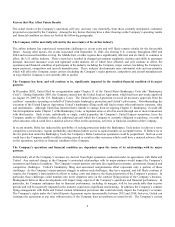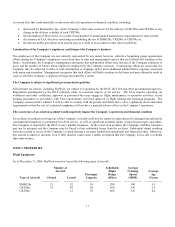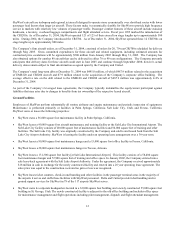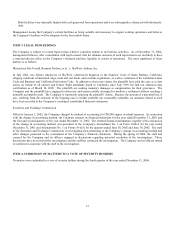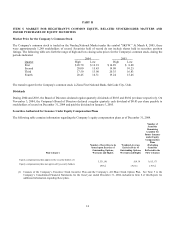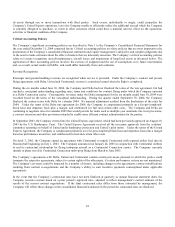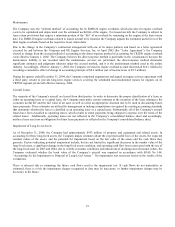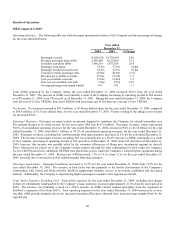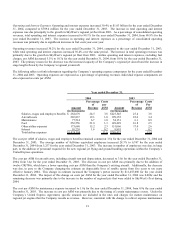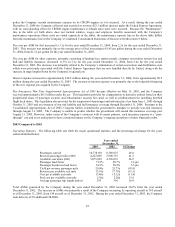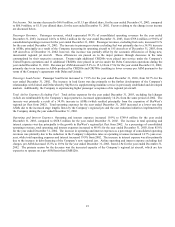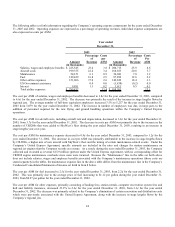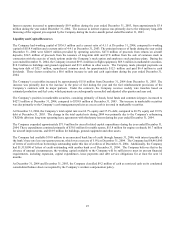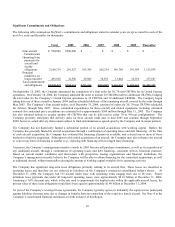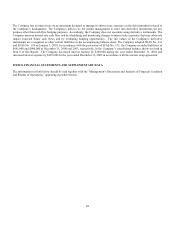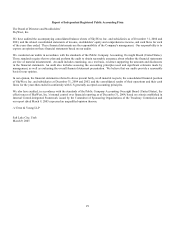SkyWest Airlines 2004 Annual Report Download - page 21
Download and view the complete annual report
Please find page 21 of the 2004 SkyWest Airlines annual report below. You can navigate through the pages in the report by either clicking on the pages listed below, or by using the keyword search tool below to find specific information within the annual report.19
Maintenance
The Company uses the “deferral method” of accounting for its EMB120 engine overhauls, which provides for engine overhaul
costs to be capitalized and depreciated over the estimated useful life of the engine. For leased aircraft, the Company is subject to
lease return provisions that require a minimum portion of the “life” of an overhaul be remaining on the engine at the lease return
date. For EMB120 engine overhauls related to leased aircraft to be returned, the Company adjusts the estimated useful lives of the
final engine overhauls based on the respective lease return dates.
Due to the change in the Company’s contractual arrangement with one of its major partners and based on a letter agreement
executed by and between the Company and GE Engine Services, Inc. in April 2002 (the “Letter Agreement”), the Company
elected to change from the accrual method of accounting to the direct-expense method of accounting for CRJ200 engine overhaul
costs effective January 1, 2002. The Company believes the direct-expense method is preferable in the circumstances because the
maintenance liability is not recorded until the maintenance services are performed, the direct-expense method eliminates
significant estimates and judgments inherent under the accrual method, and it is the predominant method used in the airline
industry. Accordingly, effective January 1, 2002, the Company reversed its engine overhaul accrual that totaled $14.1 million by
recording a cumulative effect of change in accounting principle of $8.6 million (net of income taxes of $5.5 million).
During the quarter ended December 31, 2004, the Company completed negotiations and signed an engine services agreement with
a third party vendor to provide long-term engine services covering the scheduled and unscheduled repairs for engines on its
CRJ700 regional jet aircraft effective January, 2004.
Aircraft Leases
The majority of the Company's aircraft are leased from third parties. In order to determine the proper classification of a lease as
either an operating lease or a capital lease, the Company must make certain estimates at the inception of the lease relating to the
economic useful life and the fair value of an asset as well as select an appropriate discount rate to be used in discounting future
lease payments. These estimates are utilized by management in making computations as required by existing accounting standards
that determine whether the lease is classified as an operating lease or a capital lease. Substantially all of the Company's aircraft
leases have been classified as operating leases, which results in rental payments being charged to expense over the terms of the
related leases. Additionally, operating leases are not reflected in the Company’s consolidated balance sheet and accordingly,
neither a lease asset nor an obligation for future lease payments is reflected in the Company's consolidated balance sheet.
Impairment of Long Lived Assets
As of December 31, 2004, the Company had approximately $933 million of property and equipment and related assets. In
accounting for these long-lived assets, the Company makes estimates about the expected useful lives of the assets, the expected
residual values of the assets, and the potential for impairment based on the fair value of the assets and the cash flows they
generate. Factors indicating potential impairment include, but are not limited to, significant decreases in the market value of the
long-lived assets, a significant change in the long-lived assets condition, and operating cash flow losses associated with the use of
the long-lived asset. In 2003 and 2004, due to volatile economic conditions and indications of declining aircraft market values, the
Company evaluated whether the book value of the Company’s aircraft was impaired in accordance with SFAS No. 144,
“Accounting for the Impairment or Disposal of Long-Lived Assets.” No impairment was necessary based on the results of the
evaluations.
There is inherent risk in estimating the future cash flows used in the impairment test. If cash flows do not materialize as
estimated, there is a risk the impairment charges recognized to date may be inaccurate, or further impairment charges may be
necessary in the future.


